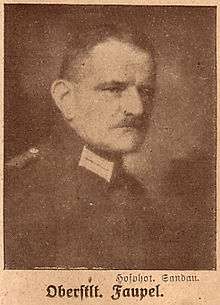Eberhard von Stohrer
Eberhard von Stohrer (May 2, 1883 – March 7, 1953) was a career German diplomat who served during World War I and World War II. The son of an Army General from Württemberg, he studied at Leipzig University, receiving a Doctor of Law degree. He also studied at the University of Strasbourg and the School of Political Sciences in Paris.
Beginnings as a diplomat
In 1909, he joined the German diplomatic corps, becoming attaché of the embassy in Sofia, Bulgaria. In 1910, he was transferred to London, and in 1912 to Brussels. After a short period of time in Berlin with the central office of the Imperial Ministry of Foreign Affairs, he moved to Madrid, where he learned to speak fluent Spanish and organized an intelligence network closely associated, apparently, to German Ambassador Leopold von Hoesch. In 1925, he married Maria Ursula von Stohrer, née von Gunther. She was the daughter of cavalry officer Franz von Günther and Ilse von Koch, born in Wannsee, Berlin, who spent her childhood between Berlin and the countryside.
After World War I, he moved to Berlin, and rose through the ranks of the diplomatic corps. In 1927, he was named Germany's envoy to Egypt, and he negotiated a treaty of friendship between Germany and the Kingdom of Hijaz in 1929.[1] He was an avid automobile racer and became lost during an April 1936 race between Cairo and the Bahariya Oasis.[2]
Diplomatic missions in Spain
During the Spanish Civil War from July 1936 to April 1939, he stayed in Madrid, acting as an observer and spy of the Second Spanish Republic and reporting news to the Nazi government in Berlin. Artillery General Wilhelm Faupel was the Nazi envoy to General Francisco Franco's Salamanca headquarters from February to October 1937. There is evidence however that von Stohrer presented his credentials as Ambassador of Germany at Salamanca on 27 August 1937 as ordered from Berlin.


He was then appointed German ambassador to Romania, where he served until 1939, when he returned to Berlin. He participated in Operation Willi, the German plot to kidnap the Duke of Windsor. He participated in the role during negotiations between the two countries, earlier than 8 July 1940, about Operation Felix, the proposed German seizure of Gibraltar.
Franco-Hitler meeting at Hendaye
He was one of the organizers of the Meeting at Hendaye on the Spanish-French border, 23 October 1940, of Adolf Hitler and Joachim von Ribbentrop, with General Francisco Franco and Franco´s brother in law Ramón Serrano Suñer).
He was not present in the personal encounter between Hitler and Franco.
Connections with the Grand Mufti of Jerusalem
Panarabist German connections with Near East politicians were specially cultivated by von Eberhard in the 1920s and 1930s.
Notes
- Schwanitz, p. 132
- Special cable to the New York Times. "Reich envoy to Egypt lost in desert in an auto race", The New York Times. April 20, 1936. Page 8.
References
- Schwanitz, Wolfgang. Germany and the Middle East, 1871–1945, Markus Wiener Publishers, (2004).
- Reinhard Liehr, Günther Maihold und Günther Vollmer (Editors): Ein Institut und sein General. Wilhelm Faupel und das Iberoamerikanische Institut in der Zeit des Nationalsozialismus. Frankfurt, (2003)
- Samuel Hoare, 1st Viscount Templewood, Ambassador on Special Mission, Collins ed. (1946), 320 pages. No ISBN registration as it was printed before 1970. Edited in Spanish translation by Sedmay ed. Madrid (1977) .
- Charles B. Burdick. Germany's Military strategy and Spain In World War II. Syracuse Univ. Press, Syracuse, U.S.A., (1968). 228 pages. ISBN 978-0-608-18105-9
- Paul Preston (1995). The Politics of Revenge: Fascism and the Military in Twentieth-century Spain. Routledge. pp. 69–70. ISBN 0-415-12000-4
- MacGregor Knox, (2000),Common Destiny: Dictatorship, Foreign Policy, and War in Fascist Italy and Nazi Germany (Cambridge University Press, ISBN 978-0-521-58208-7, p. xi. Excerpt available at Google Books.
- Carlos Caballero Jurado, Atlas Ilustrado de la División Azul, Edit. Susaeta. Hardback, 252 pages, ISBN 978-84-677-0202-6 . Octobere (2009). In Spanish
- Germany's Spanish Volunteers 1941–1945, The Blue Division in Russia, Text by John Scurr, colour Plates by Richard Hook. Osprey Men at Arms 103. Series. ISBN 978-0-85045-359-1 . Paperback. 48 pages. Osprey Publishing, England. publ. 24 July 1980.